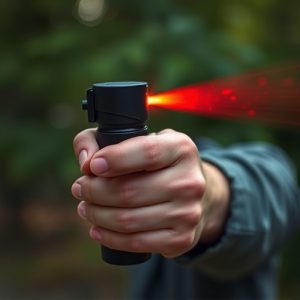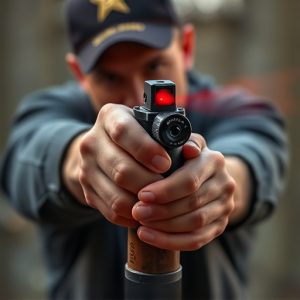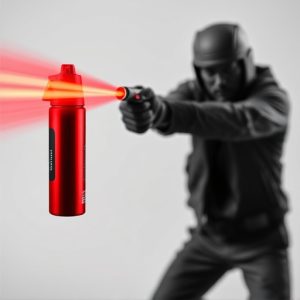Mastering Non-Lethal Deterrents: Pepper Spray, Safety, and Legalities
Non-lethal deterrents like pepper spray offer protection without permanent harm, temporarily disabli…….
Non-lethal deterrents like pepper spray offer protection without permanent harm, temporarily disabling aggressors. However, they require proper training and immediate emergency treatment, including managing exposure, medical attention, and de-escalation. While effective, these tools should be used as a last resort. Emergency treatment for pepper spray attacks involves moving to safety, rinsing eyes with water for 15 minutes, removing contaminated clothing, washing affected skin, taking deep breaths of fresh air, using a humidifier, and staying hydrated. Consulting legal professionals is recommended due to varying regional restrictions. Responsible usage includes secure storage, proper maintenance, aiming for sensitive areas, ensuring good ventilation, and immediate post-exposure care.
“Personal security is a top concern in today’s world, prompting many individuals to seek effective non-lethal deterrent devices. This comprehensive guide explores various options, with a focus on pepper spray as a popular choice. We delve into its pros and cons, offering insights for informed decisions. From selection tips to emergency treatment guidelines and legal considerations, this article equips readers with knowledge to enhance their safety. Learn how to navigate potential threats and understand the crucial steps for recovery should you encounter an attacker using pepper spray.”
- Understanding Non-Lethal Deterrent Devices: A Comprehensive Overview
- The Role of Pepper Spray in Personal Security: Pros and Cons
- How to Choose the Right Non-Lethal Self-Defense Tool for You
- Emergency Treatment After a Pepper Spray Attack: Step-by-Step Guide
- Legal Considerations and Safety Tips for Carrying Non-Lethal Deterrents
Understanding Non-Lethal Deterrent Devices: A Comprehensive Overview
Non-lethal deterrent devices are innovative tools designed to protect individuals and mitigate potential threats without causing permanent harm. These devices operate on the principle of deterring aggressors through various non-fatal methods, offering a crucial alternative in personal security. One of the most well-known examples is pepper spray, which temporarily incapacitates an attacker by irritating their eyes and respiratory system, providing enough time for escape or assistance to arrive.
Understanding the mechanics behind these devices is essential when considering their effectiveness. Non-lethal weapons aim to balance protection with proportionality, ensuring that force is used as a last resort. In the event of an attack, proper training in the use of such devices and immediate emergency treatment after pepper spray attacks can significantly improve outcomes. This includes knowing how to manage exposure, seek medical attention if needed, and de-escalate situations to prevent further violence.
The Role of Pepper Spray in Personal Security: Pros and Cons
Pepper spray, a non-lethal deterrent, plays a significant role in personal security, offering both pros and cons for those seeking to protect themselves. As an effective self-defense tool, it can create a temporary but powerful advantage during potentially dangerous encounters. The primary benefit lies in its ability to incapacitate an attacker, allowing the user to escape or seek help. It’s especially useful in close-quarters confrontations, providing a non-violent response that can disrupt and deter aggressive behavior.
However, there are considerations regarding emergency treatment after a pepper spray attack. Since pepper spray irritates the eyes, nose, and respiratory system, immediate medical attention is crucial for those affected, particularly in cases of prolonged exposure or severe reactions. Unlike other non-lethal weapons, its effects can persist, leading to discomfort and potential health risks if not handled properly. Thus, understanding the correct usage and post-exposure care is essential for anyone considering pepper spray as a personal security device.
How to Choose the Right Non-Lethal Self-Defense Tool for You
Choosing the right non-lethal self-defense tool is a personal decision that depends on your unique circumstances and preferences. Consider factors like your comfort level with different devices, budget, and specific needs in an emergency. Pepper spray, for instance, is a popular option known for its effectiveness in disorienting attackers while allowing time to escape unharmed. However, it’s crucial to understand the emergency treatment required after a pepper spray attack, such as seeking fresh air and washing affected areas.
Other options include personal alarms, stun guns, or tasers, each with its own strengths and weaknesses. Alarms can be loud enough to startle assailants, while stun devices deliver electrical shocks that temporarily paralyze them. When making your choice, ensure the device is easily accessible, reliable in various weather conditions, and suitable for your level of physical ability.
Emergency Treatment After a Pepper Spray Attack: Step-by-Step Guide
In the event of a pepper spray attack, immediate and proper emergency treatment is crucial to mitigating discomfort and potential health risks. The first step is to move to a safe location away from the source of the spray. If possible, seek medical attention promptly; call emergency services or visit a hospital for professional care.
If you are unable to seek immediate medical help, begin by rinsing your eyes thoroughly with clean water for at least 15 minutes. Remove any clothing that may have come into contact with the pepper spray and wash it immediately. Ensure your skin is also thoroughly washed with soap and water. Take deep breaths of fresh air to help clear your respiratory system. If irritation persists, consider using a humidifier or inhaling steam from boiling water to aid in breathing comfort. Lastly, keep yourself hydrated by drinking plenty of water; this can help flush out any remaining pepper spray chemicals.
Legal Considerations and Safety Tips for Carrying Non-Lethal Deterrents
When carrying a non-lethal deterrent, such as pepper spray, it’s crucial to be aware of local laws and regulations. Different regions have varying restrictions on the type, quantity, and accessibility of self-defense devices. Before purchasing or using any non-lethal deterrent, individuals should research and understand their legal rights and obligations. Consulting with a legal professional is advisable for personalized guidance, especially when traveling to areas with potential variations in self-defense laws.
Safety tips are essential for responsible deterrence device usage. Always keep the spray in a secure, easily accessible location, preferably on your person. Ensure regular maintenance and check expiration dates. During an encounter, aim for the eyes and face, as these areas provide the fastest de-escalation due to temporary blindness and respiratory distress. Proper ventilation is critical; avoid using pepper spray in enclosed spaces to prevent inhalation by bystanders or yourself. Post-emergency treatment for a pepper spray attack involves seeking immediate water or neutralizing eye wash, removing contaminated clothing, and monitoring for any adverse symptoms.
In conclusion, non-lethal deterrent devices, particularly pepper spray, offer a crucial tool for personal security. Understanding their pros and cons, choosing the right fit, and knowing emergency treatment after a pepper spray attack are essential steps towards empowerment. Always stay informed about legal considerations to ensure safe carrying practices. With proper knowledge and preparation, individuals can confidently navigate potential threats, enhancing their safety in various situations.


